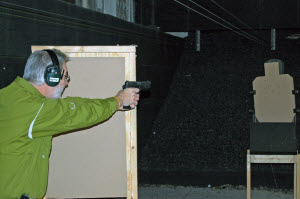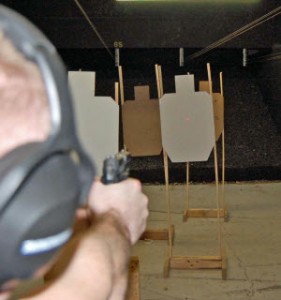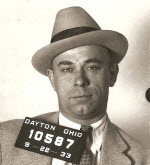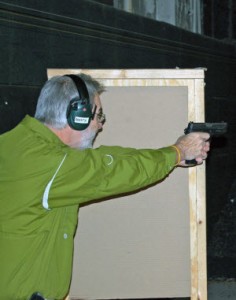 Training for real gunfights is a tricky business. The reality is that very little is known about law enforcement officers involved in dynamic critical incidents. Even less is known about civilians who are involved in such incidents.
Training for real gunfights is a tricky business. The reality is that very little is known about law enforcement officers involved in dynamic critical incidents. Even less is known about civilians who are involved in such incidents.
Rob Pincus accurately points out that there are four factors that affect your ability to hit the target in a dynamic critical incident. In his book, Combat Focus Shooting: The Science of Intuitive Shooting Skill Development, he lists the four factors that affect what he calls the balance of speed and precision.
- 1. Distance to the target
- 2. Size of the target
- 3. Circumstances under which you shoot
- 4. Anticipation of the need to shoot
In this article, I will examine the distance at which you will likely have to shoot.
Anyone who has been in a training class has heard a version of this: “Eighty percent of gunfights happen in less than three seconds and at less than 20 feet.” We say this, but we do not really know it to be true. The only reliable statistics for distances of dynamic critical incidents are maintained when a law enforcement officer (LEO) is killed in the line of duty. That information is not readily available when an LEO is involved in a shooting but not killed, and those statistics are not collected for civilian shootings.
Perhaps this is an urban legend handed down through the training community over time without any statistical fact. But it may be accurate. As a trainer and curriculum writer, I wanted to know the truth.

Using pop-up targets can simulate a close ambush attack. Moving back to cover while engaging multiple targets induces stress and requires quick thinking and action.
The Search for Statistics
I confirmed the information with the FBI and Department of Justice. There are no reliable statistics on civilian shootings in the United States. I also confirmed that 80% of LEO shootings between 2000 and 2009 happened at 20 feet or less. This statistic has been similar over the last several decades. It would seem this is the basis for the belief that 80% of all shootings happen at less than 20 feet. So we have some verifiable basis in fact. But are circumstances for civilian shootings different than shootings involving LEOs? Do LEOs get closer to make arrests and therefore get involved in close-range shootings? Do civilians wait until the last minute to pull the trigger in self-defense?

Laser aiming devices have benefits and weaknesses. Train the way you fight and fight the way you train. Use the same equipment on the range that you carry in self-defense.
Tom told me that 56 of his students have “had to use a handgun to defend themselves or family members.” He said that of the 56 students, two were in physical contact with the attacker. In three cases, the defender was forced to fire at 15 yards or beyond. The longest was 22 yards. Tom uses the length of a typical car as a training distance. He said, “Confrontational distances are conversational distances, for the most part.” This certainly makes sense and matches up with my experience investigating shootings during my law enforcement career.
Another LEO and Combat Focus Shooting Instructor, Jamie Onion, reinforces the point. “I think that most civilian shootings involve one of two dynamics: escalated arguments or ambushes. That statistically would merit CQB [Close Quarter Battle] or just beyond two arms’ reach.”
So, Tom Givens has some pretty reliable statistics. It also parallels what we see in LEO shootings, although Tom’s numbers reflect that 90% are at seven yards or less. One reason for the slight increase may be described by Butch Arnold. Butch is a staunch Second Amendment advocate, gun sales professional at Vandalia Tactical, and veteran of a personal defense gunfight. He put it simply when he said, “Most people probably don’t feel threatened at distances greater than 20 feet.” Even though an attacker may present a legitimate threat at farther than 20 feet, most people will probably wait until the last moment to fire.

Author’s department was one of several that arrested John Dillinger during his “career.” Photo courtesy Dayton, Ohio PD.
Training for Longer Distances
What about that other 10 to 20% of shootings? Should you train for longer distances? Can a pistol be effective at longer distances? The first handgun I was issued by my police department was a Smith & Wesson Model 10. It had plain black sights, a worn heavy barrel, and was pretty much the same gun that was issued to the same police department when we arrested John Dillinger in 1933. Part of our qualification was at 50 yards. We had to hit a target consistently at 50 yards or we were out of a job. There were no fancy sights, no target grips, and no tricks. Just sight alignment and trigger press. Police officers everywhere were able to consistently hit the target multiple times at 50 YARDS.
Somewhere along the line, we got away from shooting at 50 yards and now when I teach police academies, the longest distance they shoot at is 50 FEET. We probably changed because we realized the vast majority of dynamic critical incidents happen at short distances. But what do you do if the distance is longer and you or your family is still threatened?
Remember the North Hollywood shootout in 1997? The two suspects clad in black body armor terrified the nation. But what ended the gunfight with the first suspect going down? A pistol shot to the head. Mind you, he did it himself, but an accurately placed pistol shot could have ended that incident at the beginning.
Tom Givens has an answer to this situation. He says, “We train to cover the 10% on either end of the spectrum in case we are involved in a non-typical, or not average, gunfight.” Tom had a student who had to shoot at 22 yards. When Tom talked to him afterward, the student said, “You know, when I had to shoot that guy all the way across the street, it never occurred to me that I was a statistical exception. I just had to deal with it.”
What You Can Do: Assess Your Skills
Take this information and assess your personal skills and consider what situations you may be likely to face. Attend a Combat Focus Shooting class or some similar class that is proven and effective. Good training always improves your performance and demonstrates where you need additional improvement. Do not rely on old training. When it comes to keeping yourself and your family safe, ask “What have I done for me lately?”

Some ranges do not permit movement. Stagger multiple targets at varying distances to simulate the movement of the attacker, either forward or backward.
What You Can Do: Home Audit
Something I suggest to all my students is conducting an audit of your home. Determine what the longest distance is that you may have to shoot inside the home in the event of a home invasion or other type of crime. Be sure to look at all the angles. Role play scenarios of burglaries, home invasions and other crimes. Use that scenario training to get the locations and measurements you need for a complete and accurate view of your home.
Take news stories of crimes that happen in your area and turn them into “what if” training. Ask yourself and your family, “What if that happened to us? What would we do?” Talk it out and plan from there. Will you use a handgun in that situation or do you have a shotgun or rifle available? The type of weapon system drastically changes the effectiveness of your defense.
We carry handguns because they are portable and concealable, but they are not always the best weapon available. If miscreants come to the humble Williams abode to do harm, they are likely to be greeted by a tried-and-true Remington 870 or an AR-15. Consider a long gun for home defense, but be sure you are proficient with any weapon that you count on to defend your life.
Once you compile those distances, make a training program for yourself.

Plan your training to include the use of cover and concealment by both you and the attacker. Lay out the distances and design to match those in your own home or business for specific locations you are in on a regular basis.
What You Can Do: Your Personal Training
Now that you know the distances, set up your own personalized training regimen. Get realistic targets and set them at the distances you measured. Remember that your attacker is likely to use cover and concealment, so incorporate that into the training. You can fold the targets or place cardboard over parts of the targets to represent the attacker using a couch or refrigerator or wall as cover or concealment. And remember the difference: Cover blocks incoming fire. Concealment keeps an attacker from being seen.
Combine all this to form your personalized training and emergency plan. Make your home defensible and your family tactically wise, and have the tools to keep the people you love safe from harm.
Good, comprehensive article. I think I have at least one of your books at home. I read a book a while back by a revolver guy who analyzed CCTV footage of actual attacks and critical incidents that were recorded on the streets. Was that your book? His analysis showed that the majority (@80%) happened between 2 arms lengths and 15 feet. I have a Smith J-Frame Airweight snub revolver. It kicks like a mule with +P rounds. Recently I've been keeping it loaded with 148 grain wadcutter target loads. My hand strength is declining as I age. At the range, I found that at the 6' to 15' range the recoil made it impossible for me to hit reliably within the 8" circle using +P rounds. When I switched to the softer recoiling 148gr wadcutter target rounds I could keep my shots in the ring. In one of Micullick's books, he wrote that some of his compatriots on the Stakeout Squad, started using wadcutter target loads in their revolvers because they were more effective than the standard issue round nosed bullets. I figured that a less powerful round, that I could control, was a better choice at self-defense distances than a more powerful round I couldn't keep on target. There was also less chance of overpenetration. Now, my wife won't use anything but the 148gr wadcutters in her old blued steel, J-Frame snub, chief's special revolver. +P and even some .38 Spcl loads hurt her hands. I'm a revolver guy too, many of your other articles resonate with me. Thanks.
While proven that most self-defense shootings are at very close ranges, it would behoove everyone to know what they and their handgun is capable of at 25 yards. Most are and would be fairly accurate at this distance but, it may require some practice and aiming basics. We never know what may be required of us in any given circumstance and we would all be in better shape to know that we are capable of what may be required. In my experience, it also may make closer shooting that much easier and faster. By comparison, I know what my 30-06 is capable of at 500+ yards while zeroed at 200 yards. I don't feel that I would attempt a 500 yard shot on a game animal but, I am confident in my and the rifles capability. A very good and eye opening article for us all, thanks!
Your Article Was A Great Help & Knowledge That Was Very Informative!! Thank You !!
The shootings in my Federal Agency were, with one exception, at 7 yards or less. Two that I investigated were contact distance at 3 feet. We trained at close distances because we had limited time and ammo (no, it's not like TV where everyone is a perfect shot, and we had unlimited ammo.)
Great article. My own personal training reveals that within the distance available on the range I use, the same sight picture applies regardless of the distance. I get the same hits at 20 yards as at 5 yards. It would appear that law enforcement shootings are much more likely to be at extended distances, as we frequently hear of officers shooting at subjects seated in vehicles or ranges much more than contact range. I've done the in-home measurements and tactical analysis on my own home as suggested here and it's sobering to realize how many places an intruder could hide and how difficult it would be to "clear" the place without exposing myself - indeed a task for multiple professionals.
Hi Lt., I belong to group that trains together once per month in tactical defenses, handgun, AR rifle and shotgun and this group came together coming up on two years now. The instructor is ex-military, ex-police officer. Members include ex-military, police officers and the average Joe's like me. Realistic training scenarios that place each guy in close range combative within 5' to longer distances up to 60' or further both with rifle and handgun. Each training is set to shooting as quick as a shooter is able to place rounds accurately on target in daylight, low light, no light scenarios since we conceive that more criminals are more likely to attack in low/no light times of the day. Shooting in and around objects, behind cover or concealment, on our backs, on our bellies, balancing on unstable objects, over car hood simulation, under car/obstacle shooting, sitting at a restaurant table with a friend seated across, clearing a home from outside in, working every conceivable simulation we can think of in real life scenarios. Strong and weak shooting, reloading, racking simulating a one hand wounded scenario. Targets are as small as 6" steel to full size paper targets some with hostage for shooting accuracy. I introduced moving targets that pop up giving the shooter about 1.5 to 2 seconds to draw and place rounds on target with a hostage involved within 5' to 10'. I introduced a moving target that simulates a running threat as quick as we can make it move for tracking and placing rounds on target from varied distances. In my personal weekly trainings outside the group I set targets to run drills for shot placement and speed both with handgun and rifle at varied distances and drawing from my concealed position practice. The farthest shot distances is about 60' out typically. Our training this month will include a medic to simulate real life civilian gun shot wounds and how to attend to the wounded or to ourselves. The reason I am being so descriptive is because your article hits the target right in the snot locker/head. It's scary to think of how many people being the vast majority that carry concealed that do not train to use their weapon regularly or at all. They operate under the premise that I'm safe because I have a gun on me and That's nothing shy of stupid dangerous! How do they expect to place a shot on target if they do not practice and or practice real life scenarios?? How about the mind thought of "when" is the right time to use lethal force or should I?? Will they shut down and freeze in a real life threatening situation?? Zero muscle memory... Standing in line anywhere, sitting in a restaurant, driving in a car, walking in a mall, riding a bike, attending a concert, pumping gas #1 situational awareness?? Thank you for sending the message and it would be great to hear from those of your readers that actually practice regularly in numbers?? CCW - 9MMAN
Really good information-puts the confrontation and distance issue in perspective so we can train for it with some degree of confidence
I think many CCW holders never consider that their "situation" might involve needing to "engage" at longer distances that 20 feet. They carry firearms that they have never practiced with shooting at 15 or 25 yards. Many carry "sub-compact" firearms that are hard to shoot accurately at distances great than 20 ft. or so, at least without serious practice. I am a retired LEO and still occasionally "workout" with my carry guns at 25 to 50 yards just so I know the guns and I are still capable if I'm outside of the usual statistics.
As a former police officer what you state makes sense. The dynamic leading up to, or setting the stage if you prefer, to a conflict is different between a Law Enforcement Officer and a civilian. Excellent article.
I'm confined to a wheelchair and it is difficult for me to find articles that cover these mobility issues. I do shoulder carry a 9mm or 357 magnum... any info would be much appreciated. Thank you.